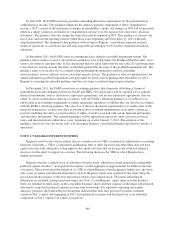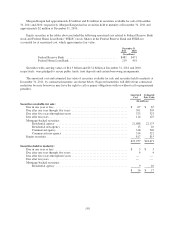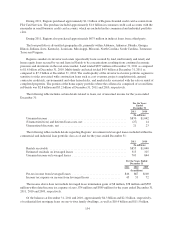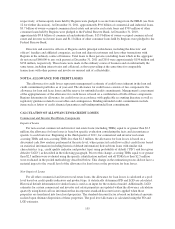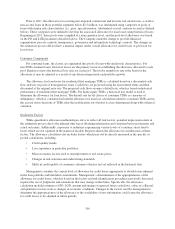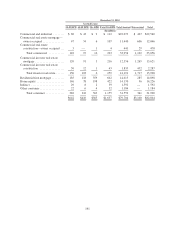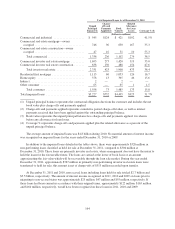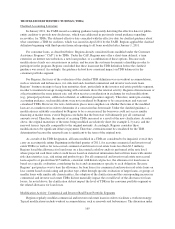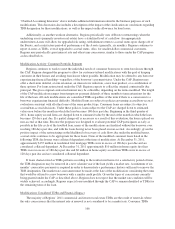Regions Bank 2011 Annual Report Download - page 180
Download and view the complete annual report
Please find page 180 of the 2011 Regions Bank annual report below. You can navigate through the pages in the report by either clicking on the pages listed below, or by using the keyword search tool below to find specific information within the annual report.
Prior to 2011, the allowance for accruing non-impaired commercial and investor real estate loans, as well as
non-accrual loans in those portfolio segments below $2.5 million, was determined using categories of pools of
loans with similar risk characteristics (i.e., pass, special mention, substandard accrual, and non-accrual as defined
below). These categories were utilized to develop the associated allowance for loan losses using historical losses.
Beginning in 2011, these pools were compiled at a more granular level, and the pool-level allowance was based
on the PD and LGD parameters described above. The Company made the change to provide enhanced
segmentation, process controls, transparency, governance and information technology controls. The changes in
the estimation process did not have a material impact on the overall allowance for credit losses or provision for
loan losses.
Consumer Components
For consumer loans, the classes are segmented into pools of loans with similar risk characteristics. For
non-TDR consumer loans, historical losses are the primary factor in establishing the allowance allocated to each
pool. Regions reviews the historical loss rates for each pool. The twelve month loss rate is the basis for the
allocation; it may be adjusted as a result of any deteriorating trends and portfolio growth.
The allowance for loan losses for residential first mortgage TDRs is calculated based on a discounted cash
flow analysis on pools of homogeneous loans. Cash flows are projected using the restructured terms and then
discounted at the original note rate. The projected cash flows assume a default rate, which is based on historical
performance of residential first mortgage TDRs. For home equity TDRs, a historical loss model is used to
determine the allowance for loan losses. The default rate for all classes of consumer TDRs is a measure of
delinquency, which is considered in both the allowance for loan loss calculation related to consumer TDRs and in
the accrual status decisions of TDRs after the modification, for which it is a key determinant along with collateral
valuation.
Qualitative Factors
While quantitative allowance methodologies strive to reflect all risk factors, potential imprecision exists in
the estimation process due to the inherent time lag of obtaining information and variations between estimates and
actual outcomes. Additionally, exposures to industries experiencing various levels of economic stress lead to
losses which are not captured in the statistical models. Regions adjusts the allowance in consideration of these
factors. The allowance calculation also includes factors which may not be directly measured in the specific or
pooled calculations, including:
• Credit quality trends,
• Loss experience in particular portfolios,
• Macroeconomic factors such as unemployment or real estate prices,
• Changes in risk selection and underwriting standards,
• Shifts in credit quality of consumer customers which is not yet reflected in the historical data.
Management considers the current level of allowance for credit losses appropriate to absorb losses inherent
in the loan portfolio and unfunded commitments. Management’s determination of the appropriateness of the
allowance for credit losses, which is based on the factors and risk identification procedures previously discussed,
requires the use of judgments and estimations that may change in the future. Specifically, the allowance
calculation includes estimates of PD, LGD, amount and timing of expected future cash flows, value of collateral,
and qualitative factors such as changes in economic conditions. Changes in the factors used by management to
determine the appropriateness of the allowance or the availability of new information could cause the allowance
for credit losses to be adjusted in future periods.
156


